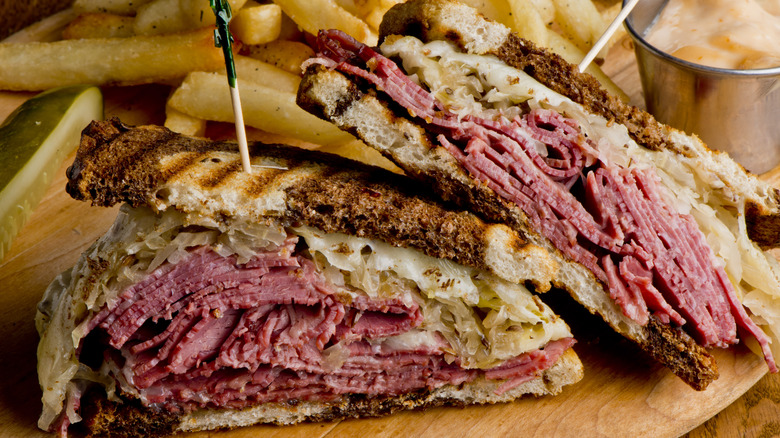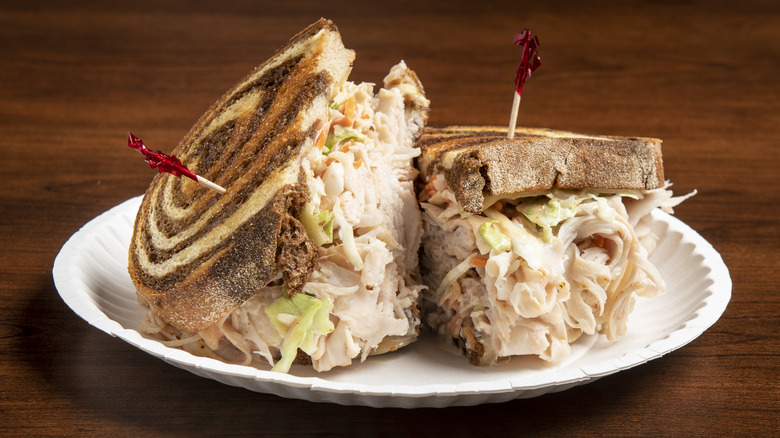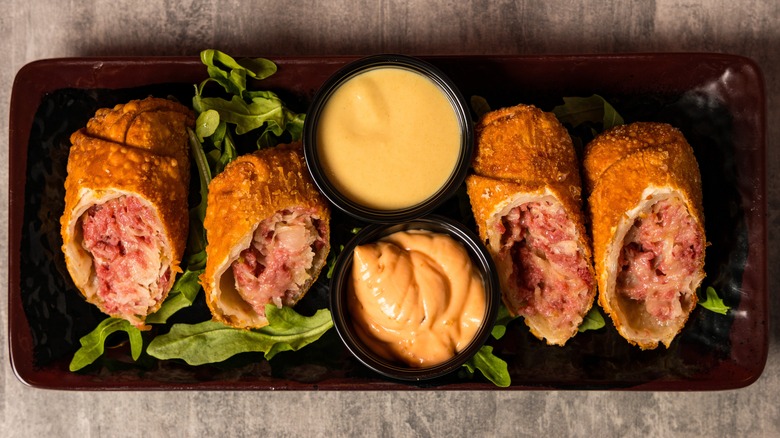What Separates A Reuben From A Rachel Sandwich?
Scan the menu at a New York deli, and you're likely to notice two sandwiches with similar names: the Reuben and the Rachel. Both sandwiches rely on the delicious alchemy of Swiss cheese, Russian dressing, and rye bread. Where they mainly differ, however, is the choice of meat and vegetables in each 'wich.
There are conflicted reports on when and how the Reuben was invented. One story states that in the 1920s, a poker player named Reuben Kulakofsky assembled the sandwich from a deli platter while playing cards at an Omaha hotel. Others credit grocer Bernard Schimmel with making the sandwich and serving it to Kulakofsky, while yet another story attributes it to New York restauranteur Arnold Reuben. Though its origins may be debatable, everyone agrees that a Reuben must layer the cheese, dressing, and bread with corned beef and sauerkraut. Crucially, the sandwich is always grilled and served hot.
The Rachel, meanwhile, replaces the corned beef with turkey and the sauerkraut with coleslaw. Pastrami is occasionally used instead of turkey, and a mention of a pastrami sandwich bearing the Rachel name dates back to 1993, and a version with chicken goes back as far as the 1930s. The Rachel ends up being a creamier sandwich due to the extra mayo in the coleslaw, and also a crunchier one because of the use of fresh cabbage. Just like its "brother," though, it's griddled to crispy perfection before serving.
Tips for great Ruebens and Rachels
Making a Rachel or Reuben sandwich isn't difficult, but both require careful attention to detail for the best results. First of all, you need to start with high-quality ingredients. This is most important when it comes to your meat options, so shell out for hearty slices of turkey or a well-respected brand of corned beef. You need some first-rate bread, as well. Slice this bread fairly thick, as both sandwiches are fairly messy, and thinner bread will wilt or break apart underneath the moisture of the sauce. Jewish-style rye is the traditional choice , though some Rachel recipes use sourdough.
You can use a store-bought dressing for your sandwich, or you can make your own tangy Russian dressing to amp up the flavor. To toast the sandwich, spread slices of butter on the sides of the bread you want facing outward, then assemble the sandwich and griddle the whole thing in a skillet so that everything melts together and the flavors merge. Keep the stove's heat low, so that your bread doesn't burn in the time it takes for the cheese to melt. If you want to speed up the process, try warming the corned beef and sauerkraut (or just the turkey, for a Rachel) separately before layering the sandwich. The warm ingredients will help the cheese melt more quickly.
More Reuben variations
The Rachel is far from the only variation on the Reuben out there. Some of these take the classic ingredients of the sandwich and transport them to a different format. In Detroit, Reuben egg rolls have become a regional specialty. This dish rolls up corned beef, sauerkraut, and Swiss cheese in an egg roll wrapper, then it's finished in the deep fryer. To get rid of the carb component entirely, try this pork loin "Reuben," in which the sandwich's ingredients are rolled inside of butterflied pork tenderloin. Or, go in the opposite direction and amp up the starch with a Reuben arancini recipe.
Other versions across America adapt local ingredients to the Reuben format. In Minnesota, walleye fish is subbed in for the beef, while Florida offers a Reubenesque sandwich (sorry, we had to) made with grouper. Meanwhile, Quebec has their own spin using local Montreal smoked meat. This product is similar to corned beef, but it contains less sugar in its brine, and is smoked like pastrami. Vegetarian versions of the sandwich abound, too, with meat alternatives ranging from beets (to imitate the red color of corned beef) to mushrooms (for their meaty, umami flavor).



